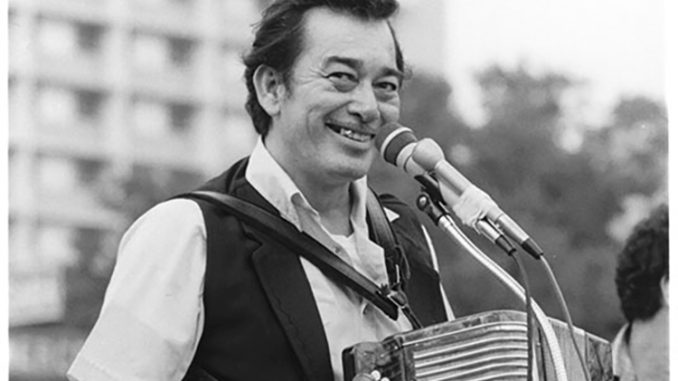
Photo: Flaco Jiménez at the annual Tejano Conjunto Music Festival, San Antonio, Texas, 1982. Photo by Chris Strachwitz, courtesy of the Arhoolie Foundation.
“If you only just push one button and you push it with heart, that’s all you need—the heart, the alegría (joy).” —Leonardo “Flaco” Jiménez
Smithsonian Folkways Records published a tribute to Tex-Mex accordion master Flaco Jiménez (1939–2025) who passed away last week on Thursday, July 31, at 86 years old. A towering figure in American roots music, Jiménez brought homegrown Texas conjunto to the world, reaching the ears, souls, and dancing feet of fans far beyond his native San Antonio.
In 2014, Jiménez and longtime collaborator Max Baca of Los Texmaniacs released the album Flaco & Max: Legends & Legacies on Smithsonian Folkways. Jiménez’s colorful style and creative spirit shine through across decades of recordings—from his very first sessions as a teenager to his influential work with Arhoolie Records found in our collection, including his 1986 GRAMMY-winning performance on ¡Ay Te Dejo en San Antonio y Más!
Dan Sheehy, Smithsonian Folkways director and curator emeritus, shared the following remembrance: “‘Flaco’ was all anyone ever needed to say. Everyone into conjunto tejano knew him. You could say they admired him, but the greater truth was they loved him. He was a thousand-watt bulb that lit up the world around him—humble, kind, creative, hilarious, and overflowing with life. And he loved them back. I often recall the heartwarming father-son bond between Flaco and his musical right-hand-man and disciple of a half-century, bajo sexto master Max Baca. In the recording session for the Flaco and Max: Legends and Legacies album, Max spoke of Flaco’s renown as a ‘llenasalones’ (dancehall-filler). But even more, he was a ‘llenacorazones’ (heart-filler). Gracias, hermano Flaco. Que en paz descanses.”
FLACO JIMÉNEZ – A HISTORY (SMITHSONIAN/FOLKWAYS)
“What B.B. King is to the blues, or George Jones is to traditional country, GRAMMY-winning accordionist Flaco Jiménez is to the world of Tex-Mex conjunto.”
Leonardo “Flaco” Jiménez, beloved musician from the Texas-Mexico borderlands, composed and shaped some of the most iconic recordings in conjunto, tejano and norteño music over the course of his seven-decade career, substantially elevating the profile of each genre in the process. He was able to preserve the roots of these traditions while never hesitating to embrace new directions, often blending his musical heritage with country, rock, and jazz. In his words, “you have to play what’s going on in the world.” Through both his solo career and collaborations with artists as varied as Linda Ronstadt, Buck Owens, and The Rolling Stones, Jiménez left a profound mark on the history of music, building lasting bridges between previously disparate genres and inspiring generations of audiences and musicians alike.
Born into a long line of musicians in San Antonio, Texas, Jiménez became adept at guitar and bajo sexto while he was still in grade school. His grandfather, Patricio Jiménez, was an accordionist who played in polka and waltz groups, and his father, Don Santiago Jiménez, was a professional Tex-Mex musician whose recordings helped to popularize the norteño and conjunto music of the 1940s and ’50s. Flaco contributed bajo sexto to some of his father’s final albums, but during his teenage years he was inspired by the records of pioneering zydeco musician Clifton Chenier to shift his focus to the accordion. At age 15, Jiménez started to record and play live with his first band, Los Caporales, and soon found himself to be a local celebrity within the conjunto music scenes of Texas.
Jiménez’s profile continued to rise, and in 1973 he was asked by the renowned Tex-Mex musician Doug Sahm to contribute accordion to his debut album, which included appearances from musical mainstays like Bob Dylan and Dr. John. These collaborations helped to establish Jiménez’s national reputation as a master of conjunto, and in 1976, Ry Cooder invited him to contribute to Chicken Skin Music, Cooder’s first exploration of Tex-Mex traditions. Following his appearance on Cooder’s album, Jiménez was invited to join the roster of Arhoolie Records, and in 1977 he recorded Flaco Jiménez y Su Conjunto, his first album to be distributed outside of the American Southwest. Through the 1980s and ’90s Jiménez continued releasing new recordings and reissuing earlier works with Arhoolie Records.
Jiménez continued to tour and record extensively, winning his first GRAMMY in 1987 and appearing on Dwight Yoakam and Buck Owens’ chart-topping country single “Streets of Bakersfield” in 1988. He joined forces with Doug Sahm once again in 1989, forming the supergroup known as The Texas Tornados with fellow Tejano stars Freddie Fender and Augie Myers. In 1992, Jiménez made his debut on Warner Bros. Records with the hit album Partners, which included appearances from Stephen Stills, Emmylou Harris, and Los Lobos. In 1994, he made a guest appearance on The Rolling Stones’ Voodoo Lounge, and in 1999, he won his fourth GRAMMY, making him the most awarded artist in the history of the GRAMMY’s “Best Mexican/Mexican-American Album” category—this time for his contributions to Los Super Seven’s debut album. Jiménez was a mentor to Max Baca, the leader of the GRAMMY Award-winning group Los Texmaniacs, and in 2014 the pair released the collaborative album Flaco & Max: Legends & Legacies on Smithsonian Folkways, capturing the essential sounds of the conjunto tradition. “We don’t forget our roots; we stick to our roots,” Flaco said about the album. “Conjunto music is the fiesta thing, fun and dancing, or whatever. It’s having a good time.”
Jiménez went on to receive lifetime achievement awards from both Billboard and the GRAMMYs, as well as a National Heritage Fellowship from the National Endowment for the Arts. He continued to tour and record into his seventies, and in 2017 a photo of Jiménez was hung in the National Portrait Gallery. In 2022 he was awarded a prestigious National Medal of Arts by the United States government, “for harnessing heritage to enrich American music.” His legacy as a conjunto pioneer and master of the accordion will live on through his groundbreaking recordings and the countless artists he continues to inspire.
“Flaco’ was all anyone ever needed to say” writes Dan Sheehy, Smithsonian Folkways director, curator emeritus, and friend of the artist. “Everyone into conjunto tejano knew him. You could say they admired him, but the greater truth was they loved him. He was a thousand-watt bulb that lit up the world around him—humble, kind, creative, hilarious, and overflowing with life. And he loved them back. I often recall the heartwarming father-son bond between Flaco and his musical right-hand-man and disciple of a half-century, bajo sexto master Max Baca. In the recording session for the Flaco & Max: Legends & Legacies album, Max spoke of Flaco’s renown as a ‘llenasalones’ (dancehall-filler). But even more, he was a ‘llenacorazones’ (heart-filler).”

